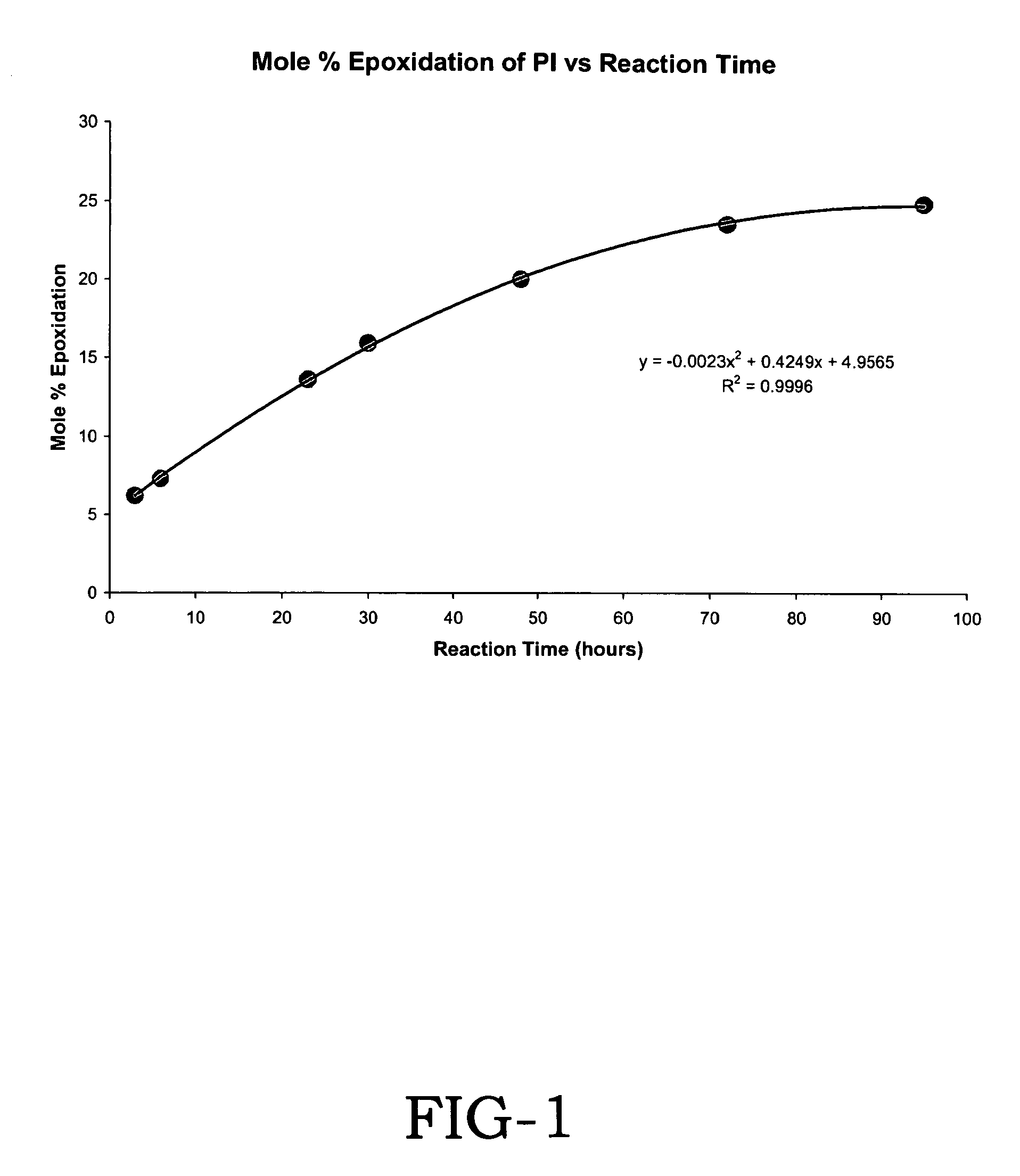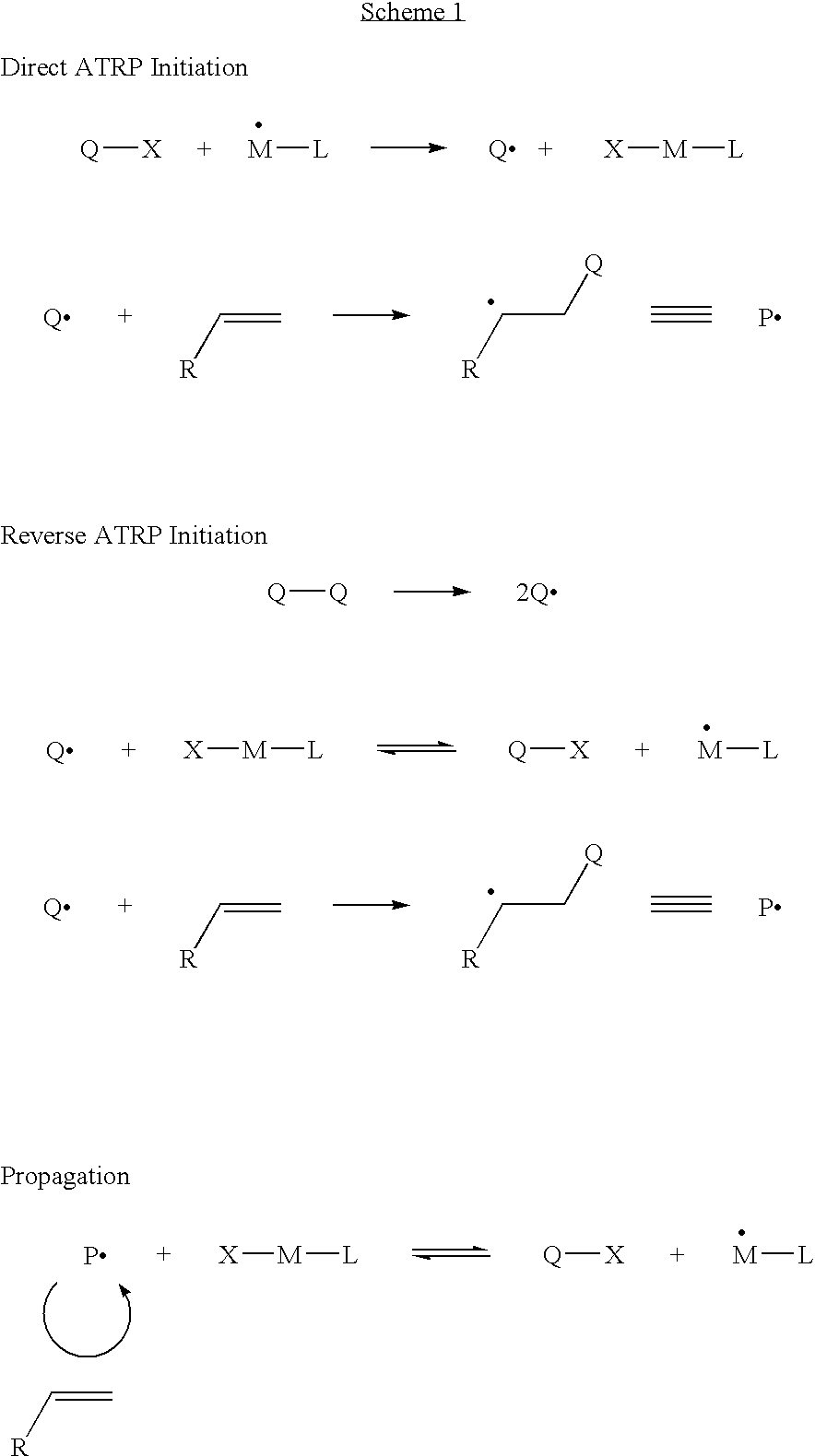Hydrogenation and epoxidation of polymers made by controlled polymerization
a polymerization and polymerization technology, applied in the direction of granular delivery, pharmaceutical delivery mechanism, medical preparations, etc., can solve the problems of slow initiation, slow transport, and inconvenient use of conventional emulsion polymerization techniques for controlled polymerization
- Summary
- Abstract
- Description
- Claims
- Application Information
AI Technical Summary
Benefits of technology
Problems solved by technology
Method used
Image
Examples
example 1
Surfactant Systems for In-Situ Emulsification in Styrene
[0156]A series of reactions were performed to identify latent surfactant / surfactant activator combinations for in-situ emulsification. In a typical reaction, solutions of latent surfactant (˜0.2 grams) in styrene (5 milliliters) and surfactant activator in water (5 milliliters) were prepared. The aqueous solution was then added to the styrene solution with gentle stirring to generate an emulsion. Selected latent surfactant / surfactant activator combinations that produced an emulsion are summarized in the table below:
[0157]
EntryLatent SurfactantSurfactant Activator(s)1Palmitoyl ChlorideKOH2Palmitoyl ChlorideDiethanolamine / KOH3Palmitoyl ChlorideGlycine / KOH4Palmitoyl Chloride3-aminopropanephosphonic acid / KOH5Palmitoyl Chloride3-aminopropanesulphonic acid / KOH6Palmitoyl Chloride(2-aminoethyl)trimethylammoniumchloridehydrochloride / KOH7HexadecylamineSuccinic anhydride8Hexadecylamine1,3-Propanesultone / KOH9HexadecylamineHCl10Hexadecyliso...
example 2
Polymerization of Controlled Mn & PDI Polystyrene by RAFT
[0158]A 2-gallon reaction vessel was initially charged with 1,000 grams of styrene, 60.0 grams of oleic acid and 7.2 grams of dibenzyltrithiocarbonate. The reactor was then flushed with nitrogen, briefly evacuated and charged with an aqueous solution comprising 4,000 gram of RO water, 40.0 grams of potassium persulfate, 40.0 grams of tripotassium phosphate and 16.4 grams of potassium hydroxide. Immediately upon mixing the aqueous solution with the organic, a fine microemulsion forms. The mixture is then rapidly heated to 65° C. Complete conversion to a stable, slightly yellow polystyrene latex is achieved in less than 1.5 hours. Solids after stripping were 20.6%. GPC analysis of the final polymer gave a Mn of 54,000 with a PDI of 1.17.
example 3
Polymerization of Controlled Mn & PDI Polystyrene by RAFT Using an In-Situ Generated Polymerizable Surfactant
[0159]A 2-gallon reaction vessel was initially charged with 1,000 grams of styrene, 60.0 grams of the hexadecyl half ester of maleic acid and 7.2 grams of dibenzyltrithiocarbonate. The reactor was then flushed with nitrogen, briefly evacuated and charged with an aqueous solution comprising 4,000 grams of reverse-osmosis (RO) water, 40.0 grams of potassium persulfate, 40.0 grams of tripotassium phosphate and 16.4 grams of potassium hydroxide. It should be noted that immediately upon mixing the aqueous solution with the organic, a fine microemulsion forms. The mixture is then rapidly heated to 65° C. Complete conversion to a stable, slightly yellow polystyrene latex is achieved in less than 3 hours. Solids after stripping were 23.7%. GPC analysis of the final polymer gave a Mn of 48,000 with a PDI of 1.17.
PUM
| Property | Measurement | Unit |
|---|---|---|
| size | aaaaa | aaaaa |
| time | aaaaa | aaaaa |
| time | aaaaa | aaaaa |
Abstract
Description
Claims
Application Information
 Login to View More
Login to View More - R&D
- Intellectual Property
- Life Sciences
- Materials
- Tech Scout
- Unparalleled Data Quality
- Higher Quality Content
- 60% Fewer Hallucinations
Browse by: Latest US Patents, China's latest patents, Technical Efficacy Thesaurus, Application Domain, Technology Topic, Popular Technical Reports.
© 2025 PatSnap. All rights reserved.Legal|Privacy policy|Modern Slavery Act Transparency Statement|Sitemap|About US| Contact US: help@patsnap.com



